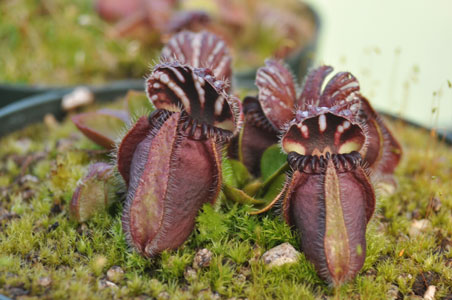Cephalotus follicularis Care
Get the straight facts from guys who grow and propagate thousands of carnivorous plants every year.

The West Australian pitcher plant is unique among all carnivorous plants. This ground-hugging pitcher plant evolved independently from Sarracenia, Darlingtonia, Heliamphora, or Nepenthes, and is native to a narrow strip of coastline in Southwestern Australia. Cephalotus produces small clumps of colorful thumb-size pitchers, which range from orangey-reds, to maroons, to almost black. Upon closer inspection, you can see a line of "teeth" lining the rim of each pitcher. There is only one species in the genus, Cephalotus follicularis. If you're new to growing carnivorous plants, consider trying out a Nepenthes or tropical sundew before investing in this rare and oftentimes challenging gem. Cephalotus cultivation is idiosyncratic among carnivorous plants, straddling the blurry line between tropical and cold-hardy, and is more complicated to keep in comparison to Nepenthes or tropical Drosera.
Range
Cephalotus are native to the Southwestern coastal region of Australia, around the city of Albany. Albany has relatively mild summers and winters, and brief episodes of light frost occur commonly during the winter months.
Where to Grow
Cephalotus is technically a warm-temperate plant (USDA zones 9 and 10) and is capable of tolerating a light frost, so if you live in zones 9 or warmer, you could grow your plant outdoors. If you live in zones 8 or colder, you could grow your plant in a cold frame with other temperate plants. (See below for winter care.) Otherwise, grow your plant indoors as a tropical houseplant. A terrarium is not required.
Heat Tolerance
Cephalotus has the reputation of being finicky when it comes to heat. In our early experience with Cephalotus, we believed that it couldn’t tolerate temperatures above 90°F (32°C). However, through much trial and error, we found that a drop in nighttime temperature below 70°F (21°C) is essential if day temperatures are very warm. Plants in our collection occasionally experience temperatures as high as 100°F (43°C) in the summer. But our summer nighttime temperatures are usually in the 50s. Cephalotus would experience this type of temperature cycle, with warm days and cool nights, in its native habitat.
Sunlight
Cephalotus requires partial to full sun. Grow it in a location where it can receive approximately 4 or more hours of direct sunlight and bright filtered sunlight throughout the rest of the day. The cooler direct morning sun is ideal.

Artificial Lights
If a sunny window is not possible, use a couple of 40-watt fluorescent tubes or compact fluorescent bulbs of similar output. Keep the light source approximately 8 inches above the plant. The light should be on for 14 hours during spring and summer, and 12 hours during fall and winter. Avoid using incandescent bulbs. They produce too much heat and the wrong type of light spectrum. Even incandescent “grow-lights” are inappropriate for carnivorous plants.
Water
In cultivation,
Cephalotus prefers damp moist soil instead of waterlogged soil. Their water preferences are similar to those of Nepenthes and Heliamphora. If you have other houseplants and keep to a regular watering schedule, you can include Cephalotus in your routine, top watering it and draining it into a tray or saucer. The soil should be moist at all times and never allowed to dry out. You can otherwise keep Cephalotus in a tray with the water level no higher than ¼ of the way up the pot. This provides the roots moisture and aeration. However, if the water level is too high for too long (if the crown of the plant is closer than 4 or so inches to the water table) the roots may succumb to rot.
Cephalotus is also very sensitive to water with dissolved mineral levels of 50 ppm or more, so use mineral-free water whenever possible.
Soil
Like other types of tropical pitcher plants, Cephalotus is tolerant of a variety of mixes as long as it is nutrient-free and well-drained. Our favorite mix is equal parts sphagnum moss and perlite. This mixture provides excellent drainage and aeration. Never use conventional potting soil, compost, or fertilizer. They will kill your plant.
Winter Care
In its native habitat,
Cephalotus will experience a winter rest of approximately three months during which time the daytime temperatures are cooler (55° - 70°F, 13° - 21°C) and daylight hours are shorter. It will continue to grow, but growth will slow down dramatically and the plant will produce an abundance of flat, non-carnivorous leaves.
Winter rest is an essential part of this plant’s care. Many growers have reported that their adult Cephalotus that they’ve had for many years suddenly died for no apparent reason. Stress related to years of growing without a winter rest might be the reason why.
If you are growing your plant in a windowsill, your plant will naturally experience a winter rest by the decrease in daylight hours. Just make sure the plant is away from any strong heat source, such as a heater or vent.
If you are growing your plant in a cold frame greenhouse, your plant will actually go dormant and stop growing altogether. During its dormancy, it can tolerate brief episodes of a light frost. Use a heater to maintain a minimum temperature of 35°F (2°C) if daytime temperature falls below freezing.

They experienced a short bout of snow with no adverse effects.
Low temperatures were about 26°F (-3°C).
Repotting
Cephalotus dislikes having its roots disturbed. Use a tall plastic pot that is preemptively too big for its size. After that, change the soil every other year. The best time of the year to repot your plant is in late winter or early spring while the plant is in its winter rest.
